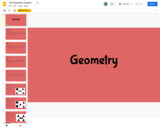
This collection of google slides is for use with Grade 2 students as a math routine to increase geometry vocabulary and critical thinking skills.
- Subject:
- Mathematics
- Material Type:
- Learning Task
- Author:
- Abby Goodman
- Date Added:
- 06/02/2021

This collection of google slides is for use with Grade 2 students as a math routine to increase geometry vocabulary and critical thinking skills.

This five- part writing lesson is aimed at the middle elementary grades. After a read- aloud, students guess why the authors chose to represent each letter with a particular word and then summarize the pattern of the book. Students use the pattern to create their own class alphabet book.
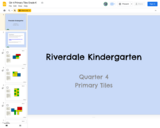
This google slide show, adapted from Steve Wyborney's site, organizes primary tiles tasks for fourth quarter kindergarten students. It focuses on subitizing and creating addition equations to represent a total.
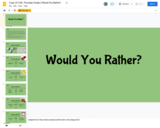
This google slide show organizes "Would You Rather?" questions in a sequence by weeks. This series is recommended for second graders in the third quarter. Teachers can use these with students to promote number sense and precise mathematical vocabulary. Students will construct viable arguments and discuss their choices mathematically.
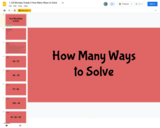
This google slide show is a collection of equations within the second grade math standards. When presenting the slides, each student should think of several different ways to solve the equation. Emphasize trying to find different ways besides using the standard algorithm (pictures, counting up, using familiar numbers or compensation, etc.)
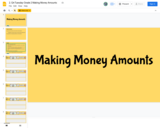
This collection of google slides is designed to give second grade students practice with making a given amount of money in various ways. Teachers facilitate by encouraging students to find as many ways to make the amount as possible and in leading discussion around what is most efficient.
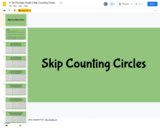
This set of google slides is created to organize a skip counting routine. Students sit or stand in a circle. The teacher gives students the starting number, and they start skip counting around the circle. Identify or circle numbers on hundreds chart as students say them, discussing any patterns.
For an extra game, play “elimination” - choose a number that you know will be reached, and whoever says that number sits down. Continue picking numbers to eliminate until there is just one student left standing.
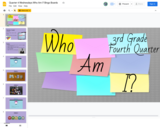
This google slide show organizes "Who Am I?" number puzzles and "Bingo Boards" from Solve Me Puzzles at https://solveme.edc.org/ in a sequence by weeks. Puzzles are online and linked to this slide show. Teachers can use these with students to promote number sense and precise mathematical vocabulary.

Quill is our web-based tool that provides personalized, interactive writing lessons for middle school students. Each of the activities is built directly from the Common Core State Standards. Quill focuses on a single standard, and breaks it down into lessons that can be completed in 10-15 minutes. Grammar is an essential part of forming cohesive writing; it never exists in a vacuum. As such, in Quill's sentence writing activities, they require learners to rewrite the entire sentence correctly, not just choose a multiple choice answer or fill in the blank. The proofreading passages are filled with grammatical mistakes. In each of the passages, the student’s job is to identify and fix each of the errors. Quill then highlights the student’s own errors and provides a follow-up lesson on those particular subject areas. In both activities, students receive immediate feedback and are encouraged to repeat assignments until they achieve proficiency. Teachers can track which students are struggling with certain concepts and provide individualized instruction to suit their needs.
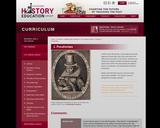
From the site: Thanks to the Disney film, most students know the legend of Pocahontas. But is the story told in the 1995 movie accurate? In this lesson, students use evidence to explore whether Pocahontas actually saved John Smith's life and practice the ability to source, corroborate, and contextualize historical documents.Please note that there are two versions of the lesson plan available. The shorter version is designed for younger students.

Reading literacy activity that focuses on ethics and specifically, the fall of Enron. Students have pre-read questions focused on ethics, and then are instructed to read the article by Dan Blohowiak (February 6, 2002) called "Enron and the Ethical Choices We All Face." Students have to identify and define unknown vocabulary as part of the reading process, and then are asked to research some background information on the fall of Enron. Last, students are asked to annotate and reflect on the article in order to identify ethical behaviors.

Reading Rotation Exit Slip
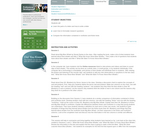
This series of eight lessons has students compare information found in fiction and non-fiction texts related to whales. Students learn to formulate research questions, interact with an online scientist and write letters using the writing process.
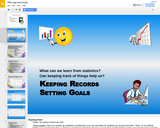
Help students create a reading log and goal that is not associated primarily with AR points. Help them to understand where they are at and where they want to go.

Students are able to decide where in Texas they are going to live and then make financial choices that will correlate with the lifetyle they think they want to have. They will decide where they live, what they buy, and what they save. Once they make all of their financial decisions, they will be given a minimum salary that they will need to be able to maintain that lifestyle. They are then able to search jobs that they are interested in and see the starting salaries that they come with. This allows them to see the reality of what their lifetyle and career path is.

Reciprocal Teaching (Palinscar & Brown 1984) is a guided reading comprehension strategy that encourages students to develop the skills that effective readers and learners do automatically (summarise, question, clarify, predict and respond to what they are reading). Students use these four comprehension strategies on a common text, in pairs or small groups. Reciprocal Teaching can be used with fiction, non-fiction, prose or poetry.
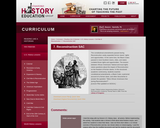
(Taken directly from website)
The constitutional amendments passed during Reconstruction vastly expanded former slaves' rights and opportunities. At the same time, the Black Codes passed in most Southern towns, cities, and states curtailed those rights and opportunities. The tension between African Americans' federal and local rights raises questions about the impact of Reconstruction on the freedom of former slaves. In this structured academic controversy, students examine constitutional amendments, a Black Code, a personal account of a former slave, and other documents to answer the question: “Were African Americans free during Reconstruction?"

Recording of Feb. 15, 2022 Advancing EL through Culturally-Relevant Text Sets, resources and discussions with participants.
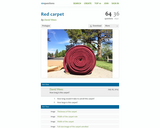
The activity begins with a photo of a large roll of red carpet. What follows are the following questions:
1) How long is the carpet?
2) How long will it take to unroll the carpet?
3) How large is the carpet?
What follows this first "ACT" are images and videos that provide students with more and more information that help them discover possible answers to these questions.
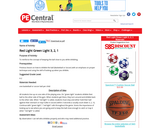
An activity that allows students to work on the skills for dribbling a soccer ball or a basketball.